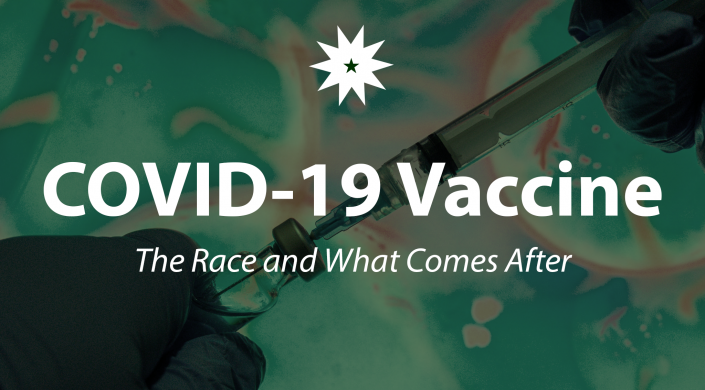Infectious disease is a constant companion to societies, propelling research and innovation to understand its transmission and prevention, and assess distribution of health resources. The COVID-19 pandemic has characterized the scientific foundations behind vaccines and its underlying issues to empower the public during a health crisis.
These conversations were enriched by COVID-19 Vaccine: The Race and What Comes After, a webinar last August 15 hosted by Project Insight, a student-driven network to develop meaningful discourse through online events featuring industry leaders and figures from academia. In union with the University of the Philippines Molecular Biology and Biotechnology Society, Labang Pangkalusugan, the Public Health Council of the Ateneo School of Medicine and Public Health, Asian Medical Students’ Association-Philippines, and De La Salle University-Science College Government, the online panel discussion tackled the processes that govern vaccine development, public health concerns, and accessibility on both local and global scales.
‘What is a vaccine?’
Dr. Salvador Caoili, associate professor from the University of the Philippines College of Medicine, recalled that COVID-19 is a communicable or contagious disease caused by the SARS-CoV-2 virus and is spread mainly through respiratory droplets when we sneeze, cough, talk, or breathe.
“For COVID-19, our hope is that we will be able to find a vaccine that can protect a substantial portion of the population,” stated Roderick Salenga, World Health Organization Papua New Guinea Technical Officer for Pharmaceuticals. He added that vaccines are “important public health tools” that introduce certain molecules, like a weakened virus or its genetic material, to accustom the body’s immune system to recognize the virus and prevent disease.
Caoili clarified, however, that since little information is known about SARS-CoV-2, multiple variations of the COVID-19 vaccine are developed to avoid risking resources in one vaccine that may not work for all people. Similarly, our own immune systems “don’t make a single antibody for any particular virus. We actually make polyclonal antibodies, [which] hit the virus from a number of different points.”
Regardless of the type of vaccine, the process remains the same. Researchers would first come up with “a very detailed picture” of the pathogen or disease-causing agent, then list and pick out components or “possible ingredients” for the vaccine.
Using smallpox as an example, Caoili explained that vaccines in the past injected the weakened version of the actual virus to healthy people, compared to today where scientists have been able to develop a safer method that replicates the genetic material of the virus instead, using it to train the body’s immune response with less risks or ethical issues. This is, however, just one of the many issues surrounding vaccine development, as Caoili cited, “You’d have to ask questions like ‘Does it need refrigeration in the long run?’; ‘How much would it cost?’; and ‘At what point would you try it on a human subject?’”
Agents in vaccine development
Health product availability raises concerns both at a local and international level. Collaborations between pharmaceutical companies and the academe—which lie in the process of development regulated by authorities—hope to translate the scientific insights born from experimentation in laboratories to practical levels that are accessible to the masses.
At the experimentation level, clinical trials are essential in ensuring the understanding of a vaccine candidate’s effects on humans and its ability to stimulate an immune response. “We start [trials] with usually just tens of numbers of people just to really look at the safety [of the candidate], and we only enroll very healthy individuals,” revealed Dr. Carleigh Krubiner, an associate faculty at the Johns Hopkins Berman Institute of Bioethics.
Later phases of development involve a few hundred participants to observe the immunogenicity and potential for a promising intervention. “In the case of COVID vaccines, these trials are really, really large,” she explained. “Several thousands of subjects are needed to look at whether or not this [vaccine] is going to be effective enough.”
With larger scale trials and a fast-tracked process, COVID-19 vaccine development has accelerated compared to the typical 10 to 15 year process. Some wonder how news of clinical advancements happen so quickly, but for Caoili, the fast-paced movement to treat COVID-19 presents an “opportunity for us to see if we can actually do things more efficiently and faster without sacrificing considerations.”
According to Krubiner, openness and transparency in reporting the findings and data are a must, to ensure that these vaccines are going through all the necessary testing stages and are “adhering to regulatory standards”. Referencing the Dengvaxia scare, she also highlighted the importance of gaining the public trust, “There’s a large portion of society that doesn’t really trust [vaccines].”
Many continue to speculate how vaccine development procedures can transition from production to distribution in developing countries. Accessibility concerns arise as the Global Alliance for Vaccines and Immunization’s (Gavi) draft allocation mechanism aims to target only 20 percent of the population, deemed at high risk in terms of age and comorbidities or underlying medical conditions, with three percent constituting healthcare workers as the top priority. Krubiner stated that Gavi is involved in these procurement programs and is “trying to bring in both purchasers and donors from higher-income settings to create enough purchasing power” to assist lower and middle-income nations.
Wary about waiting
As months of quarantine pass and governments continue attempts at responding to the pandemic situation, citizens wait for breakthroughs in vaccine research.
Salenga suggested that we do not entirely depend on the promise of a vaccine; instead, other interventions like restricting social mobility and wearing face masks are also needed. He acknowledged that society cannot survive only through lockdowns, citing consequences for the workforce employed under “no work, no pay” schemes; the pandemic is not just a “public health threat, but a socio-economic issue”, he noted, and therefore requires decisions and policies that strike a “balance between [the] economy and public health.”
Caoili cautioned that there is no “silver bullet” for COVID-19, emphasizing, “The vaccine [is] just another piece of the puzzle. It shouldn’t give us a false sense of security.”

